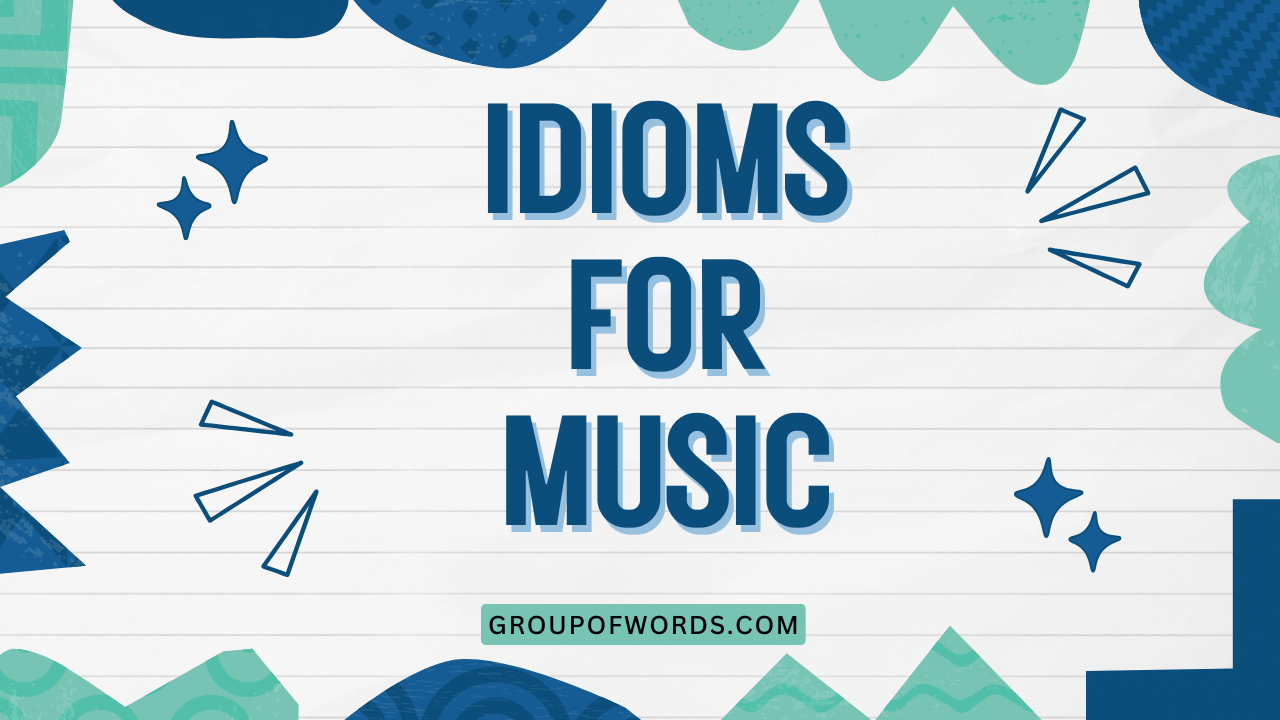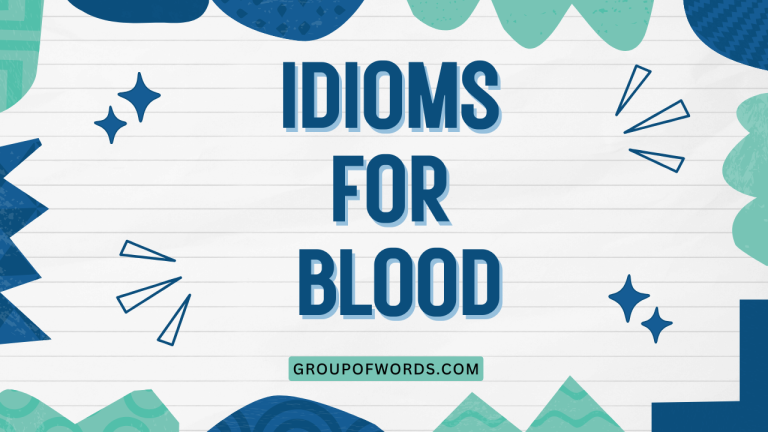Musical Idioms: A Comprehensive Guide to Melodic Expressions
Idioms add color and depth to the English language, allowing us to express complex ideas in concise and imaginative ways. Musical idioms, in particular, draw upon the rich world of music to convey emotions, situations, and behaviors.
Understanding these idioms not only enhances your comprehension of English but also enriches your appreciation for the cultural connections between language and music. This guide is designed for English language learners of all levels, from beginners to advanced speakers, who wish to expand their vocabulary and grasp the nuances of idiomatic expressions related to music.
Table of Contents
- Introduction
- Definition of Musical Idioms
- Structural Breakdown of Musical Idioms
- Types and Categories of Musical Idioms
- Examples of Musical Idioms
- Usage Rules for Musical Idioms
- Common Mistakes with Musical Idioms
- Practice Exercises
- Advanced Topics: The Origins and Evolution of Musical Idioms
- Frequently Asked Questions
- Conclusion
Definition of Musical Idioms
A musical idiom is a phrase or expression that uses musical terms or concepts to convey a meaning that is different from the literal interpretation of the words. These idioms often reflect cultural attitudes and experiences related to music, providing a metaphorical way to describe various aspects of life. Musical idioms function as a type of figurative language, adding richness and nuance to communication. They are classified as idioms because their meaning cannot be deduced simply by understanding the individual words within the phrase. Instead, the entire expression must be learned as a unit.
The function of musical idioms is primarily to add color and expressiveness to language. They allow speakers and writers to convey complex emotions, situations, or ideas in a concise and memorable way.
The context in which these idioms are used is crucial for understanding their intended meaning. For example, the idiom “to face the music” does not literally mean to stand in front of an orchestra; rather, it means to accept the consequences of one’s actions.
Structural Breakdown of Musical Idioms
Musical idioms, like all idioms, do not follow standard grammatical rules in terms of literal meaning. Their structure is fixed, meaning the words cannot be changed or rearranged without altering or destroying the idiom’s intended meaning.
They typically consist of a combination of nouns, verbs, adjectives, and adverbs, linked together in a specific order to create a figurative expression.
The key to understanding the structure of musical idioms lies in recognizing that they operate on a metaphorical level. For instance, in the idiom “play second fiddle,” the verb “play” and the noun “fiddle” are used metaphorically to represent a subordinate role.
The structure is important; changing it to “play the fiddle second” would not convey the same idiomatic meaning. Therefore, learning musical idioms involves memorizing the specific words and their arrangement within the phrase.
Types and Categories of Musical Idioms
Musical idioms can be categorized based on the specific musical concept they reference. Here are some common categories:
Harmony-Related Idioms
These idioms use concepts related to musical harmony, such as chords, keys, and dissonance, to describe situations involving agreement, balance, or conflict.
Rhythm-Related Idioms
These idioms draw on the idea of rhythm, tempo, and beat to represent the pace, timing, or flow of events.
Performance-Related Idioms
These idioms relate to the act of performing music, including rehearsals, stage presence, and audience reception, to describe various aspects of human behavior and social interactions.
Instrument-Related Idioms
These idioms use musical instruments as metaphors to describe roles, skills, or characteristics of people or situations.
Examples of Musical Idioms
Here are some examples of musical idioms, categorized by the musical concept they relate to.
Harmony-Related Examples
The following table provides examples of harmony-related idioms, along with their meanings and example sentences. These idioms often deal with agreement, discord, or being in sync with others.
| Idiom | Meaning | Example Sentence |
|---|---|---|
| Strike a chord | Resonate emotionally with someone; evoke a feeling or memory. | The speaker’s story really struck a chord with the audience. |
| Sing from the same hymn sheet | To be in agreement; to share the same views or opinions. | The team needs to sing from the same hymn sheet if they want to succeed. |
| Change your tune | To alter your opinion or behavior, often because it is in your interest to do so. | He completely changed his tune when he realized who I was. |
| Blow your own trumpet | To boast about your own talents or achievements. | She’s too modest to blow her own trumpet, but she’s a brilliant scientist. |
| Music to my ears | Something that is very pleasing or welcome to hear. | The news that I got the job was music to my ears. |
| Call the tune | To be in control; to make the important decisions. | In this company, the CEO calls the tune. |
| Off-key | Slightly wrong or inappropriate. | His joke was a little off-key, considering the serious nature of the discussion. |
| In concert | Working together in agreement. | The countries acted in concert to address the climate crisis. |
| Clear as a bell | Very clear and easy to understand. | The instructions were as clear as a bell. |
| Like a broken record | Repeating the same thing over and over again. | He sounds like a broken record, always complaining about the same things. |
| A one-hit wonder | A person or group known for only one successful song or product. | The band was a one-hit wonder and quickly faded into obscurity. |
| As harmonious as a choir | Working very well together, in a pleasing and coordinated manner. | The team worked as harmoniously as a choir to complete the project on time. |
| In the pipeline | In the process of being developed or prepared. | We have several new products in the pipeline. |
| Fine-tune | To make small adjustments to something in order to improve it. | We need to fine-tune the marketing strategy to reach a wider audience. |
| March to the beat of your own drum | To behave independently and unconventionally. | She’s always marched to the beat of her own drum, and I admire her for it. |
| Strike the right note | To say or do something that is suitable or appropriate for a particular situation. | He managed to strike the right note in his speech, balancing seriousness and humor. |
| A song and dance | An elaborate or complicated explanation or excuse, often used to avoid answering a direct question. | He gave me a whole song and dance about why he was late, but I didn’t believe him. |
| With bells on | Eagerly and enthusiastically. | I’ll be there with bells on! |
| Play it by ear | To improvise; to decide how to deal with a situation as it develops, rather than planning it in advance. | We don’t have a set plan, we’ll just play it by ear. |
| It takes two to tango | Both parties are responsible for a conflict or situation. | Their marriage failed, but it takes two to tango. |
Rhythm-Related Examples
This table focuses on idioms that use rhythm, tempo, or beat to describe the timing or flow of events. These expressions often convey a sense of pace, regularity, or disruption.
| Idiom | Meaning | Example Sentence |
|---|---|---|
| Get into the swing of things | To become accustomed to a new routine or activity. | It took me a few weeks to get into the swing of things at my new job. |
| Keep pace with | To move or progress at the same rate as someone or something else. | Small businesses struggle to keep pace with technological advancements. |
| Set the pace | To establish the speed or standard for others to follow. | Our team is setting the pace in the industry with our innovative products. |
| Miss a beat | To pause briefly or show a momentary hesitation. | She didn’t miss a beat when she answered the difficult question. |
| In sync | Operating or occurring at the same time or rate. | The dancers were perfectly in sync with the music. |
| Out of sync | Not operating or occurring at the same time or rate. | Our schedules are completely out of sync, making it hard to meet. |
| Hit the right note | To say or do something that is suitable or appropriate. | He hit the right note in his speech, balancing humor and seriousness. |
| Jam session | An informal musical gathering where musicians improvise together. | The jazz club hosted a late-night jam session. |
| A new lease on life | A chance to start over or improve one’s situation. | After the surgery, she felt like she had a new lease on life. |
| All that jazz | And other similar things; and so forth. | They sell clothes, shoes, and all that jazz. |
| Second fiddle | To play a supporting or subordinate role. | She’s tired of playing second fiddle to her more successful brother. |
| Face the music | To accept the consequences of one’s actions. | He knew he had to face the music after lying to his boss. |
| For a song | Very cheaply. | I bought the car for a song at an auction. |
| Make a song and dance about something | To complain or protest about something unnecessarily. | Don’t make a song and dance about a little scratch on the car. |
| Sing someone’s praises | To praise someone enthusiastically. | The boss was singing her praises after she closed the deal. |
| That’s my song | That resonates with me. | When she talked about overcoming adversity, I thought “that’s my song“. |
| Turn up the volume | To intensify or increase something. | We need to turn up the volume on our marketing efforts. |
| Wind someone up | To tease or annoy someone. | He loves to wind his sister up by singing loudly. |
| Fine-tune | To make small adjustments to something in order to improve it. | We need to fine-tune the presentation before we give it to the client. |
| In tune with | Understanding or agreeing with something. | The politician is in tune with the needs of his constituents. |
Performance-Related Examples
This section provides idioms that use the act of performing music as a metaphor for describing various aspects of human behavior and social interactions. These idioms often relate to skill, effort, or success.
| Idiom | Meaning | Example Sentence |
|---|---|---|
| Steal the show | To attract the most attention and praise. | The young actor stole the show with his performance. |
| A tough act to follow | A performance or achievement that is difficult to surpass. | His previous success is going to be a tough act to follow. |
| Waiting in the wings | Ready to take over a role or position when the opportunity arises. | She’s been waiting in the wings for a promotion for years. |
| Take center stage | To become the focus of attention. | The issue of climate change has taken center stage in recent years. |
| Behind the scenes | In a private or less visible way. | A lot of work goes on behind the scenes to make the event successful. |
| Curtain call | A final appearance by performers after a performance, typically to acknowledge applause. | The actors received a standing ovation and multiple curtain calls. |
| Hit the high note | To achieve a peak or success. | The company hit a high note with its record sales this quarter. |
| Face the music | Accept the negative consequences of one’s actions. | After being caught, he had to face the music . |
| Call the shots | To make the important decisions in an organization or situation. | As the manager, she gets to call the shots. |
| Off key | Not quite right; slightly inappropriate. | His joke was a bit off key, considering the seriousness of the event. |
| Sing a different tune | Change your opinion or behavior. | He started to sing a different tune once he understood the facts. |
| Pulling the strings | Secretly controlling events or people. | It’s rumored that the CEO is pulling the strings behind the scenes. |
| On stage | In front of an audience; in public. | She’s a different person on stage; she’s much more confident. |
| Read the room | To understand the mood or atmosphere of a situation. | He failed to read the room and made an inappropriate joke. |
| Take a bow | To accept praise or recognition. | After the successful presentation, the team took a bow. |
| Encore | A demand by the audience for a repeat performance. | The crowd shouted “Encore!” after the band finished their set. |
| A hard act to follow | Something very impressive that is difficult to replicate or surpass. | His performance was a hard act to follow. |
| In the limelight | The center of public attention. | She’s been in the limelight ever since she won the award. |
| Behind the curtain | Secretly or privately. | The real decisions are made behind the curtain. |
| A showstopper | An act or performance that is extremely impressive. | Her solo was a showstopper, bringing the house down. |
Instrument-Related Examples
This table showcases idioms that use musical instruments as metaphors to describe the roles, skills, or characteristics of people or situations. These expressions often highlight qualities or functions associated with the instrument.
| Idiom | Meaning | Example Sentence |
|---|---|---|
| Play second fiddle | To take a subordinate role; to be less important or influential. | He’s tired of playing second fiddle to his more successful colleague. |
| Blow your own horn | To boast about your own talents or achievements. | He’s always blowing his own horn, even when he hasn’t done anything special. |
| Call the tune | To be in control; to make the important decisions. | In this company, the director calls the tune. |
| Fit as a fiddle | In very good health; in excellent physical condition. | Despite his age, he’s fit as a fiddle. |
| Like a broken record | Repeating the same thing over and over again. | She sounds like a broken record, always complaining about her job. |
| Bang the drum for | To promote or support something enthusiastically. | The politician is banging the drum for education reform. |
| Harp on something | To talk or complain about something repeatedly. | He’s always harping on about the same old problems. |
| Sounding board | A person whose advice or opinion is sought. | She uses her best friend as a sounding board for her ideas. |
| Strike a chord | To evoke a feeling or memory; to resonate emotionally. | The movie struck a chord with audiences around the world. |
| Keep in tune | To maintain harmony or agreement. | The team needs to keep in tune to achieve its goals. |
| Second string | A backup or substitute. | He was the second string quarterback, waiting for his chance to play. |
| Turn a deaf ear | To ignore or refuse to listen to something. | The government turned a deaf ear to the protests. |
| Fine-tuned | Refined or improved through careful adjustment. | The engine was fine-tuned for maximum performance. |
| In full swing | Operating at full capacity or activity. | The party was in full swing by midnight. |
| Off-key | Inappropriate or unsuitable. | His comment was a bit off-key, given the solemn occasion. |
| March to the beat of your drum | To behave independently and unconventionally. | She always marches to the beat of her own drum. |
| Hit the right note | To say or do something appropriate. | He hit the right note with his apology. |
| Jam session | An informal music event where musicians improvise. | They had a late-night jam session at the club. |
| Turn up the volume | To increase the intensity or importance of something. | We need to turn up the volume on our marketing campaign. |
| Strike the right chord | To say or do something that resonates well with others. | His speech struck the right chord with the audience. |
Usage Rules for Musical Idioms
Using musical idioms correctly involves understanding their specific meanings and contexts. Here are some usage rules to keep in mind:
- Context is Key: Always consider the context in which you are using the idiom. Musical idioms, like all idioms, can be misinterpreted if used in the wrong situation. For example, saying “He’s fit as a fiddle” to describe someone who is angry would be inappropriate.
- Fixed Structure: Idioms generally have a fixed structure, and changing the words can alter or destroy their meaning. Avoid altering the wording of musical idioms unless you are intentionally creating a variation for humorous or stylistic effect.
- Audience Awareness: Be mindful of your audience’s familiarity with musical idioms. If you are speaking to someone who is not a native English speaker or who has limited exposure to music, it may be best to avoid using idioms altogether or to explain their meaning clearly.
- Appropriateness: Consider the formality of the situation. While idioms can add color to your language, they may not be appropriate in formal writing or professional settings.
Common Mistakes with Musical Idioms
Here are some common mistakes that learners make when using musical idioms:
| Incorrect | Correct | Explanation |
|---|---|---|
| He is fit like a violin. | He is fit as a fiddle. | The correct idiom is “fit as a fiddle,” not “fit like a violin.” |
| She blew her own trumpet too much. | She blew her own horn too much. | The correct idiom is “blow your own horn,” not “blow your own trumpet.” |
| They called the music. | They called the tune. | The correct idiom is “call the tune,” meaning to be in control. |
| I will play it with my ear. | I will play it by ear. | The correct idiom is “play it by ear,” meaning to improvise. |
| He hit the good note. | He hit the right note. | The correct idiom is “hit the right note,” meaning to say or do the appropriate thing. |
| They sang from the same song. | They sang from the same hymn sheet. | The correct idiom is “sing from the same hymn sheet,” meaning to be in agreement. |
| He is on tune with the situation. | He is in tune with the situation. | The correct idiom is “in tune with,” meaning to be in agreement or understanding. |
| She had to face with the music. | She had to face the music. | The correct idiom is “face the music,” meaning to accept the consequences. |
| He is marching on his own drum. | He is marching to the beat of his own drum. | The correct idiom is “march to the beat of your own drum,” meaning to be independent. |
| They stole the stage. | They stole the show. | The correct idiom is “steal the show,” meaning to attract the most attention. |
Practice Exercises
Test your understanding of musical idioms with these exercises. Choose the correct idiom to complete each sentence.
| Question | Options | Answer |
|---|---|---|
| 1. After failing the exam, he had to _____. | a) face the band, b) face the music, c) face the orchestra | b) face the music |
| 2. The team needs to _____ if they want to win the championship. | a) sing from the same song, b) sing from the same music, c) sing from the same hymn sheet | c) sing from the same hymn sheet |
| 3. She’s always _____ about her accomplishments. | a) blowing her own trumpet, b) blowing her own violin, c) blowing her own guitar | a) blowing her own trumpet |
| 4. We don’t have a plan, we’ll just _____. | a) play it with our ears, b) play it by ear, c) play it by heart | b) play it by ear |
| 5. His performance was _____. | a) a hard act to repeat, b) a hard act to follow, c) a hard act to copy | b) a hard act to follow |
| 6. The issue of climate change has _____. | a) taken side stage, b) taken back stage, c) taken center stage | c) taken center stage |
| 7. He’s tired of _____ to his more successful brother. | a) playing first fiddle, b) playing second guitar, c) playing second fiddle | c) playing second fiddle |
| 8. The speaker’s story really _____ with the audience. | a) struck a guitar, b) struck a chord, c) struck a drum | b) struck a chord |
| 9. She is as _____ . | a) fit as a guitar, b) fit as a drum, c) fit as a fiddle | c) fit as a fiddle |
| 10. He’s always _____ about the same old problems. | a) harping on, b) drumming on, c) singing on | a) harping on |
Advanced Topics: The Origins and Evolution of Musical Idioms
The origins of musical idioms often lie in the historical and cultural significance of music in society. Many idioms reflect the importance of music in religious ceremonies, social gatherings, and storytelling traditions.
For example, the idiom “sing from the same hymn sheet” likely originated from the practice of singing hymns together in church, symbolizing unity and agreement.
The evolution of musical idioms is influenced by changes in musical styles, technology, and cultural attitudes. As new musical genres emerge and instruments are developed, new idioms may arise to reflect these changes.
For instance, the idiom “jam session” is relatively recent, reflecting the rise of jazz and improvisational music in the 20th century.
Furthermore, the meaning and usage of existing musical idioms can evolve over time. Some idioms may become more or less common, or their connotations may shift depending on cultural trends and social norms.
Studying the origins and evolution of musical idioms provides valuable insights into the relationship between language, music, and culture.
Frequently Asked Questions
- What is the difference between a musical idiom and a musical term?
A musical term is a specific word or phrase used within the context of music theory or practice (e.g., “crescendo,” “arpeggio”). A musical idiom, on the other hand, uses musical concepts metaphorically to express a general idea or situation unrelated to music itself (e.g., “strike a chord”). Musical idioms rely on figurative language, while musical terms have literal and technical meanings within the field of music.
- Are musical idioms universal across all cultures?
No, musical idioms are not universal. They are often specific to a particular language or culture and reflect its unique musical traditions and cultural values. While some idioms may have similar equivalents in other languages, their specific wording and connotations can vary significantly. Learning musical idioms requires an understanding of the cultural context in which they are used.
- How can I improve my understanding of musical idioms?
To improve your understanding of musical idioms, focus on reading and listening to a wide range of English texts and conversations. Pay attention to how idioms are used in context and try to deduce their meaning from the surrounding words. You can also consult idiom dictionaries or online resources that provide definitions and examples of musical idioms. Practice using idioms in your own speaking and writing to solidify your understanding.
- Is it appropriate to use musical idioms in formal writing?
The appropriateness of using musical idioms in formal writing depends on the specific context and audience. In general, idioms are more common in informal or creative writing than in formal academic or professional writing. If you are unsure whether an idiom is appropriate, it is best to err on the side of caution and use more direct and literal language.
- Can I create my own musical idioms?
While it is possible to create new idioms, it is important to remember that idioms are generally established expressions that are widely understood and accepted within a particular language or culture. If you create a new idiom, it may not be understood by others unless you provide a clear explanation of its intended meaning. It is generally best to use existing idioms rather than creating your own.
- How do I know when to use a musical idiom?
Use a musical idiom when it accurately and effectively conveys the intended meaning and when it is appropriate for the context and audience. Consider whether the idiom adds color or expressiveness to your language and whether it is likely to be understood by your listeners or readers. If you are unsure, it is best to use more direct and literal language.
- Are there any musical idioms that should be avoided?
Some musical idioms may be considered outdated, offensive, or culturally insensitive. It is important to be aware of the potential connotations of idioms and to avoid using those that may be harmful or inappropriate. If you are unsure whether an idiom is acceptable, it is best to consult a dictionary or ask a native speaker for guidance.
- How are new musical idioms created?
New musical idioms typically arise through a gradual process of usage and acceptance within a particular language or culture. They may originate from specific musical events, popular songs, or cultural trends. Over time, these expressions may become more widely used and understood, eventually becoming established idioms. The process of idiom creation is often organic and unpredictable.
Conclusion
Musical idioms offer a unique and expressive way to communicate ideas, emotions, and situations by drawing on the rich world of music. By understanding the definitions, structures, and usage rules of these idioms, English language learners can enhance their comprehension and fluency.
Recognizing common mistakes and practicing with exercises further solidifies this knowledge, enabling more effective and nuanced communication.
As you continue your language learning journey, remember that idioms are a vibrant part of the English language and culture. Embrace the opportunity to explore and incorporate them into your vocabulary, enriching your ability to express yourself with creativity and precision.
Keep practicing, and you’ll soon be able to use musical idioms with confidence and flair!






